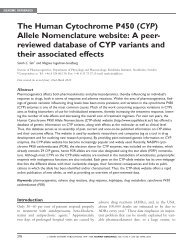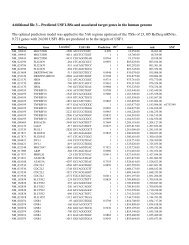Neurofibromatosis type 1-associated tumours ... - Human Genomics
Neurofibromatosis type 1-associated tumours ... - Human Genomics
Neurofibromatosis type 1-associated tumours ... - Human Genomics
Create successful ePaper yourself
Turn your PDF publications into a flip-book with our unique Google optimized e-Paper software.
REVIEW<br />
Laycock-van Spyk et al.<br />
with major nerve trunks and nerve plexi. They are<br />
generally slow growing, may develop at both<br />
internal and external body locations and can often<br />
result in major disfigurement. PNFs occur in some<br />
30–50 per cent of patients with NF1 and, although<br />
these <strong>tumours</strong> generally remain benign, some<br />
neurological impairment may result from their<br />
growth. Approximately 10–15 per cent of PNFs<br />
may become malignant.<br />
While the genetic basis of neurofibroma development<br />
is still not fully understood, biallelic NF1<br />
inactivation does seem to be required, as all tumour<br />
cells harbour both a constitutional and a somatic<br />
NF1 gene mutation. 5 About 70 per cent of PNFs<br />
have been reported to display LOH at the NF1<br />
locus; 20 however, there is no obvious correlation<br />
between the <strong>type</strong> or location of germline NF1<br />
mutations in NF1 patients and those of their<br />
somatic counterparts arising in their <strong>tumours</strong>. 20<br />
Another interesting, although as yet unexplained,<br />
observation is that a few patients mildly affected by<br />
NF1 who never develop any cutaneous neurofibromas<br />
or PNFs have been shown to carry the same<br />
germline NF1 mutation (c.2970-2972delAAT) —<br />
namely, an in-frame 3-base pair (bp) deletion that<br />
leads to the loss of a methionine residue. 3<br />
MPNSTs<br />
Cells derived from within some 10–15 per cent of<br />
PNFs may eventually undergo malignant transformation<br />
into an MPNST. MPNSTs are aggressive and<br />
highly invasive soft tissue sarcomas with an annual<br />
incidence of 0.16 per cent in NF1 patients, compared<br />
with only 0.001 per cent in the normal population, 43<br />
and with a lifetime risk of 8–13 per cent in NF1<br />
individuals 44,45 (reviewed by Upadhyaya 4 ). This form<br />
of malignancy represents a major cause of morbidity<br />
and mortality in NF1. Malignant transformation<br />
usually appears to evolve from within a pre-existing<br />
PNF. 46 The distinction between benign PNFs and<br />
MPNSTs has been sensitively visualised by noninvasive<br />
[ 18 F]-2-fluoro-2-deoxy-D-glucose positron<br />
emission tomography (FDG-PET) imaging, 47<br />
suggesting a potential role for FDG-PET-based noninvasive<br />
imaging in future diagnostic tests. The<br />
aberrant molecular pathways that underlie this malignant<br />
transformation are still largely unknown, and<br />
considerable effort is being directed towards elucidating<br />
the molecular defects involved.<br />
NF1 patients carrying large (usually 1.4-megabase<br />
[Mb]) genomic deletions (which remove the entire<br />
NF1 gene plus a variable number of flanking genes)<br />
have an increased risk of MPNST development in<br />
certain patient groups. 48,49 Indeed, over 90 per cent<br />
of MPNSTs have been found to harbour large NF1<br />
somatic deletions. 20 More recently, significantly<br />
increased frequencies (relative to the general NF1<br />
population) of PNFs, subcutaneous neurofibromas,<br />
spinal neurofibromas and MPNSTs have also been<br />
reported in association with molecularly ascertained<br />
1.4 Mb <strong>type</strong>-1 NF1 deletions. 50 The MPNST<strong>associated</strong><br />
deletion breakpoints have been found not<br />
to involve the paralogous repetitive sequences that<br />
are involved in most germline NF1 deletions. 18<br />
The smallest common region of somatic deletion<br />
overlap is, however, restricted to approximately the<br />
same ≏2.2 Mb interval that contains most of the<br />
genes deleted in recurrent constitutional NF1<br />
deletions. 51<br />
Although it is clear that biallelic NF1 gene inactivation<br />
is required for transformation to occur,<br />
mutations at the NF1 locus are insufficient to<br />
explain the process of tumorigenesis, as most<br />
benign neurofibromas also exhibit such biallelic<br />
NF1 inactivation. The best evidence for the involvement<br />
of other loci relates to the tumour protein<br />
53 gene (TP53), for which several different<br />
mutations have been found in MPNSTs that have<br />
not been reported in benign neurofibromas.<br />
4,20,52,53 Mice with heterozygous mutations in<br />
both their Nf1 and Tp53 genes developed malignancy,<br />
27,54 an indication, perhaps, that TP53 loss is<br />
critical to transformation. The homozygous loss of<br />
the cyclin-dependent kinase inhibitor 2A gene<br />
(CDKN2A), which encodes p16INK4A and<br />
p14ARF, has also been <strong>associated</strong> with NF1 malignancy.<br />
Another recent report has indicated<br />
55 – 57<br />
that phosphatase and tensin homologue deleted on<br />
chromosome 10 gene (PTEN) dosage, and/or<br />
phosphatidylinositol 3-kinase/AKT8 virus oncogene<br />
cellular homologue (PI3K/AKT) pathway<br />
626 # HENRY STEWART PUBLICATIONS 1479–7364. HUMAN GENOMICS. VOL 5. NO 6. 623–690 OCTOBER 2011





